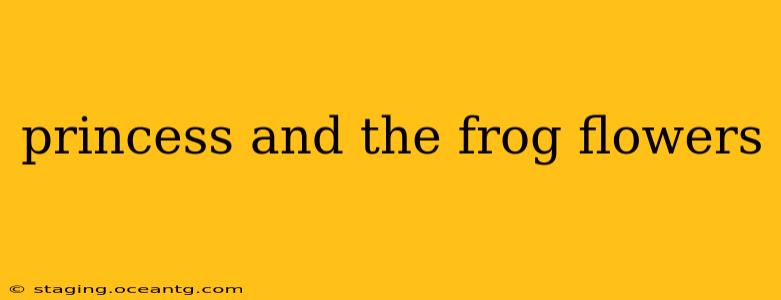Disney's "The Princess and the Frog" isn't just a charming tale of love and transformation; it's also a vibrant showcase of New Orleans' unique flora. From the lush bayous to the elegant gardens, flowers play a significant role in the film's atmosphere, symbolism, and overall beauty. This article delves into the captivating world of flowers in "The Princess and the Frog," exploring their significance and the real-life counterparts that inspired them.
What Kinds of Flowers Are in The Princess and the Frog?
The film beautifully incorporates a variety of flowers, many native to the Louisiana bayou. While specific species aren't always explicitly identified, we can recognize several types through their distinct appearances. We see abundant water lilies, their broad pads floating serenely on the water's surface, alongside vibrant hibiscus, known for their large, showy blooms in a range of colors. Orchids, with their exotic elegance, also make appearances, adding to the film's lush and tropical aesthetic. Beyond these, the film features a diverse array of flowering plants that contribute to the overall richness of the New Orleans setting. The exact species may be harder to definitively identify in some instances, as the animators took artistic liberties, but the overall effect is undeniably captivating.
What is the Significance of the Flowers in The Princess and the Frog?
The flowers in "The Princess and the Frog" aren't just decorative elements; they contribute significantly to the film's storytelling and thematic depth. They enhance the overall visual appeal, creating a vibrant and immersive world for the characters to inhabit. The lush greenery and colorful blooms of the bayou contrast with the more refined, cultivated flowers found in the city's gardens, reflecting the differences between Tiana's aspirations and her current circumstances. Further, the delicate beauty of the flowers can also be seen to symbolize hope, resilience, and the natural wonders of the Louisiana landscape.
Are the Flowers in The Princess and the Frog Realistic?
While the film takes creative liberties for artistic effect, many of the flowers depicted are rooted in reality. The animators clearly drew inspiration from the actual flora of Louisiana, aiming for authenticity in representing the region's botanical richness. While some flowers might be stylized or exaggerated for visual impact, the overall impression is one of realistic representation, contributing to the film's immersive and believable setting. The film successfully blends artistic license with a grounding in the actual plant life of the region.
What Flowers Symbolize Love in The Princess and the Frog?
Although no single flower is explicitly tied to romantic love in the film in the way a rose might be in other narratives, the overall profusion of blooms across various settings contributes to the romantic atmosphere. The vibrant colors and delicate forms of the flowers subtly enhance the scenes depicting romantic tension and blossoming relationships between the characters. The blossoming of the flowers mirrors the developing love story, creating a beautiful visual metaphor.
What Role Do Flowers Play in the Bayou Setting of The Princess and the Frog?
The flowers of the Louisiana bayou are integral to the film's setting. They're not merely background decorations; they're actively woven into the fabric of the environment. They paint a picture of a vibrant and teeming ecosystem, highlighting the natural beauty of the region and emphasizing the connection between Tiana and her environment. The flowers add depth and richness to the bayou, making it a character in itself. The lush vegetation and beautiful blooms underscore the magic and mystery of this unique location.
This analysis demonstrates that the flowers in "The Princess and the Frog" are more than just pretty visuals; they are integral to the film's narrative, symbolic meaning, and overall aesthetic success. They contribute significantly to the film's atmosphere, representing the beauty and diversity of the Louisiana bayou and adding depth to the story's themes.
